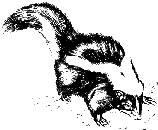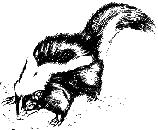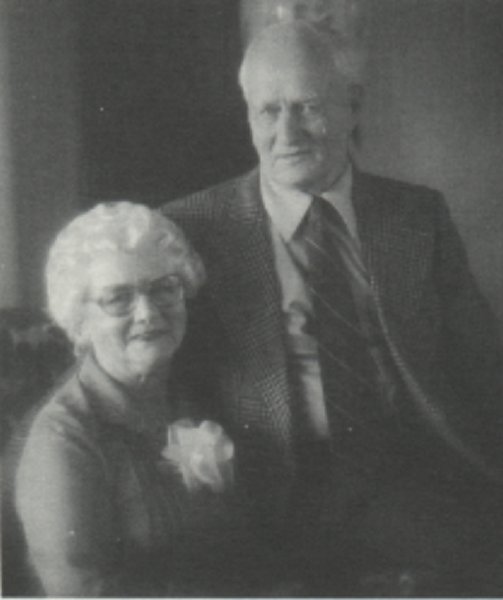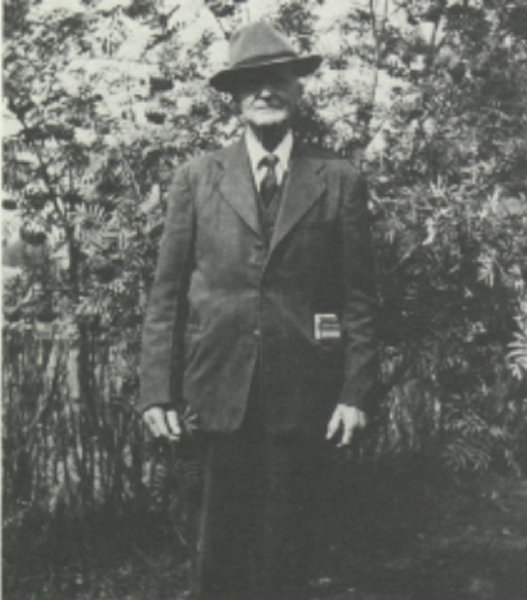


Chris Wopnford
In the summer of 1920, I was working on a farm not far from Foam Lake, Saskatchewan, when a fellow by the name of Mundi Johnson, approached me to go fishing for the winter months. There was nothing else to do for the winter, so I decided to go. I was only to be paid $85.00 per month because I had never seen a fishnet before. Good men with experience got about $100.00 to $200.00 per month, all food and expenses supplied and the railway fare to Big River paid one way. We stayed in Prince Albert overnight and left by train for Big River before noon the following day. We arrived at Big River at about 7:00 p.m. There were ten of us in the party and the man in charge was Helgi Johnson. All of us were Icelandic or of Icelandic origin. All but my cousin and I were to work for Helgi. He was the biggest producer of fish on Dore Lake at that time. He had fished for Joe Stefansson, who had quit some years earlier. I remember we asked Helgi where we would stay in Big River. He said he would try and get rooms upstairs, at the little French Baker's place, Pete Godins. It was less expensive than the Big River Boarding House, operated by the Lumber Company. O. P. Godin's was later to become the largest store in Big River. The Big River Mill was putting in their last summer of sawing, and the next spring would dismantle the mill. Most of the machinery went to The Pas, Manitoba and Giscome, British Columbia. After a day of preparations in Big River, we left for Dore Lake Frank Fowler, also known as Paddy Hines, took us to Stoney Lake by wagon. The road was very rough and had bad mudholes, so we all walked. At the south end of Stoney, we loaded everything on a big boat that was owned by the Big River Consolidated Fisheries. The man who operated the boat was Tom Young, who later operated a garage for many years in Big River. Everything went fine until we were within three or four miles of the north end of Stoney. It got very windy and then the motor stopped. We had to throw out the anchor to keep us from drifting onto the shore. Tom went down to try and start the motor - a big three-cylinder inboard with the only electrical system being a large storage battery. I went below deck to hold a lantern for him and asked what was the matter. Tom thought the battery was gone and this made him violently sick. However, he managed after some time to get the motor started. We got to the north end when it was pitch dark. When we got around the last point, we saw there was a huge campfire burning. The spring before, Helgi had made arrangements with Baptiste Mirasty to come down to Stoney Lake to meet us on October, 20th. Sure enough, he was there. However, another party had got there ahead of us that day. So the next day he took them across the portage and then came back for us the following day. We stayed at Stoney three nights and it snowed. There were no buildings or tents, but good bedrolls and some tarps. It took us all day to make the eighteen-mile portage, and then across the bay in two canoes to Mirasty's home. He had a very impressive two-storey house. Everything was very plain and mostly home-made stools and a long homemade table. When we arrived there, Helgi at once got into a conversation with the old man Mirasty, asking him about the family, how the spring trapping had been, how the garden had been, if he had any potatoes to sell, etc. At last the old man said, "I guess that's enough talking, how's about that bottle". Although Helgi never took a drink himself he always brought a bottle for the old man. On our trip, one of the fellows who was very nice but a real joker, was telling Ole Anderson, who was an innocent farm boy, not to complain about the food, because when we got up among the Indians we would likely get lynx meat, or skunk meat, which they preferred. When we were called in for supper we were very hungry after going all day with only a light lunch on the road. We enjoyed that large bowl of hot fall duck stew, bannock and blueberries. When we got back to the bunkhouse, Kris Palmasson said that the skunk meat was O.K. Poor Ole just managed to get out the door and around the corner, to throw up his supper. The next day we started for Dore Lake. The road was much worse. We had to cross some short stretches of muskeg, where the horses had to struggle to get out. We all pushed on the wagon to get through. When we got to the south end of Dore, there were no buildings there. So we built a big campfire to signal Camp Four, where the fish company and sawmill were located. After a short while, Nels Edson came to pick us up. Now, we had to get to the south end of Big Island, where our camp was. First, we had to go to Joseph's Point to get Ari Arison. We left Joseph's Point with Nels Edson's boat and a small one cylinder motor. The boat was so crowded that they were towing a small fifteen foot Chestnut canoe that was very seaworthy. Kelly Ofafasson and I were put in the small boat, with a couple of sleigh dogs and some blankets. Everything was fine until a big storm came up and we were two or three miles from the Island. The waves got so high from the east that the bow of our boat landed on the stern of the boat that was towing us. They cut us loose. We had it safely around the sand bar on the west side of the Island. We landed about a half-mile east of the west end of the south side of the Island. There we met our two employers; Tote Johnson, who later drowned on Moose Lake, in Manitoba and J.K. Johnson. We were greeted by the barking of sixty-five sleigh dogs, which they had fed for the different fishermen on Dore Lake for $12.00 per dog during the summer months. Also, they had hung many nets for fishermen for the coming winter. They had also built an addition to the camp, which made it very comfortable. That first winter fishing was very prosperous. I remember we took over 1,800 whitefish out of twenty-two nets one day. Fishing was heavy like that every day. Prices were good; 5½ cents per pound. on the Lake, with boxes supplied and freight paid by the company. Fishing lasted from December 1st to February 15th. There was no limit on the catch and no nets under 5½ inch mesh were allowed. The first freight teams to come to our camp arrived on Christmas day, bringing much-needed groceries, orders that had been left in Big River in October, also mail and fish boxes from across the Lake at Camp Four. There were about 150 teams of horses on the freight road that winter. In 1922, 23 and 24, I fished during the winter and farmed around Foam Lake, Saskatchewan during the summer months. On March 4, 1924, after returning from fishing I got married. In the fall of 1924, I went north again and my wife Lillian stayed with her parents. In May 1925, we had our first child. That winter J. K. Johnson wanted me to go north again. My wife and our young son accompanied me north to Dore Lake that winter. A Mr Ofafsson had come to Big River to buy fish for Armstrong Fisheries in Winnipeg. They were Big River Consolidated and E. G Brownsfield's competitors. Mr Ofafsson felt that by being Icelandic he would have a good chance to buy fish from many of the Icelandic fishermen. He hired Paddy Hines to drive him to Dore to visit many of the fish camps, and they agreed to take us along. The ice was quite weak for horses, so we followed the shore as much possible. When we had to cross the bays, the ice cracked too much it was quite frightening; especially for Lillian who had not experienced such a thing. More stopping places had been established along the trail. A big place at the north end of Stoney Lake, where there was no place when I went up the first years, was built the following summer. It was owned by a Greek fellow by the name of Jim Pace. We stayed at Jim's one night. Jim found a bed for us in the house, while the rest of the men slept in the bunkhouse. The baby was very good and slept as long as the sleigh was in motion, but always woke up as soon as we stopped. We arrived at the camp late in the evening on the third day and were glad to get there. The logging camp was warm and comfortable. The four men that were to fish there had arrived ahead of us. They were all busy preparing for fishing, fixing leads and floats, and cutting and hauling in wood to last us for the winter. My wife was young and it was our first child. She worried a lot about being eighty miles from a doctor or any medical help, especially when she was alone when we started fishing. We were up very early and left for the fish lines at daybreak, and returned when it got too dark to lift any more nets. The fish boxes came to us in flat bundles. We would spend the evenings nailing the boxes together for the next day. After a couple of months, we had a nice mild evening, so I took Lillian to meet Mrs Skivik. They had a fish camp about five miles away. We went with the dog team and I took a narrow portage through the Island. The fishing season was over on February 15th. We took off all leads and floats and washed the nets, hung them on racks built on the ice, and left them for one man to pick up and pack away. He would also be responsible to cut wood to have ready for the next fall. That was my last trip to Dore Lake as a fisherman. We settled in Big River where we lived for more than forty years. I worked for Waite's Fisheries for almost twenty years. I returned to Dore Lake for five years to operate the filleting plant. 
Chris and Lillian Wopnford.
Mr and Mrs Peter Fraser
by Kenneth Fraser. The Fraser family came to Big River in the spring of 1913 from Ontario. Mt and Mrs Fraser had four children: Milton, Harold, Kenneth, and Gordon. Mr Fraser was a millwright for the Ladder Lake Lumber Company, which was owned by The Winton Brothers, from the United States. He worked at this job until 1920. Peter then moved to a homestead at the south end of Ladder Lake. They later moved to Rabbit Hill, where they operated a stopping place for the freight swings. The Fraser brothers had a fish camp at Whelan's Point and fished on Dore Lake for several years. They sold their fishing outfit to John Swanson. Milton Fraser married Luella Shaw, a school teacher from Big River. Later they moved to Idaho, U.S.A. Harold married Edith McLeod, from Big River. Kenneth married Florence Crawford in 1932 and they reside in Prince Albert. Gordon married Nellie Garner from Ladder Valley. Mr. Peter Fraser passed away in 1962, at the age of 94. Mrs Fraser, Harold, Milton and Gordon have also passed away. 
Peter Fraser, age 72, 1940.
|
| Deep River Fur Farm |
| Deep River Trapping Page |
| Deep River Fishing Page |
| My Norwegian Roots |
| Early Mink People Canada - Bowness |
| The Manager's Tale - Hugh Ross |
| Sakitawak Bi-Centennial - 200 Yrs. |
| Lost Land of the Caribou - Ed Theriau |
| The History of Buffalo Narrows |
| Hugh (Lefty) McLeod, Bush Pilot |
| George Greening, Bush Pilot |
| Timber Trails - History of Big River |
| Joe Anstett, Trapper |
| Bill Windrum, Bush Pilot |
| Face the North Wind - Art Karas |
| North to Cree Lake - Art Karas |
| Look at the Past - History Dore Lake |
| George Abbott Family History |
| These Are The Prairies |
| William A. A. Jay, Trapper |
| John Hedlund, Trapper |
| Deep River Photo Gallery |
| Cyril Mahoney, Trapper |
| Saskatchewan Pictorial History |
| Who's Who in furs - 1956 |
| Century in the Making - Big River |
| Wings Beyond Road's End |
| The Northern Trapper, 1923 |
| My Various Links Page |
| Ron Clancy, Author |
| Roman Catholic Church - 1849 |
| Frontier Characters - Ron Clancy |
| Northern Trader - Ron Clancy |
| Various Deep River Videos |
| How the Indians Used the Birch |
| Mink and Fish - Buffalo Narrows |
| Gold and Other Stories - Richards |
